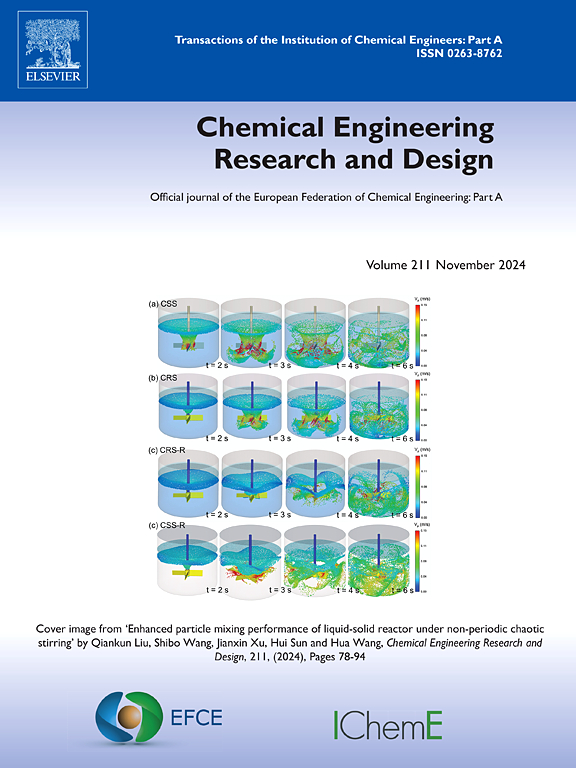First techno-economic assessment of a monoethanolamine-based CO2 capture plant applied downstream the Electric Arc Furnace for steel production
IF 3.7
3区 工程技术
Q2 ENGINEERING, CHEMICAL
引用次数: 0
Abstract
Extreme climate events, such as heatwaves and floods, are becoming increasingly recurrent and owe their existence to global warming, which has been triggered by uncontrolled atmospheric emissions of GreenHouse Gases (GHG) from various human activities. Apart from the energy sector, the industrial sector, to which the iron and steel industry belongs, ranks third in the top-five greatest anthropogenic CO2 emitting sectors. One of the mostly employed technology for CO2 removal from different gaseous streams is based on chemical absorption, with an aqueous solution of monoethanolamine (MEA) considered as the benchmark solvent. This paper is the first work in the literature assessing the technical performance of a MEA-based post-combustion CO2 capture system implemented downstream the electric arc furnace (EAF), which operates in non-steady-state conditions, at a mini-mill steel production plant and for which industrial application has recently become of interest for a cleaner steel production. A rate-based Aspen Plus® V11 model has been developed, for studying the best operating conditions for such plant via a parametric study. The effect of the lean solvent loading, αLEAN, the absorber packing height, Habs, the regenerator operating pressure, Pstp, and the regenerator packing height, Hstp, on user-defined key performance indicators (KPI) has been examined. These KPIs quantify the process performance in terms of the process requirements, thus enabling to select the best operating parameters. From all the KPIs, the thermal energy requirements (TER) at the reboiler was the one sought to be reduced the greatest. The CO2 capture plant was initially designed under the assumption of a steady flue gas flowrate entering the absorber. This assumption was later revised, leading to a proposed modification of the conventional process scheme to enable flexible operation, making this technological solution feasible and suitable for full-scale industrial application. This modification allows the plant to accommodate variations in flue gas flowrate and composition due to the intermittent operation of the EAF plant. An economic analysis indicated that the cost of CO2 removal is approximately 116$/tCO2. This cost is competitive with the current cost of the EU Emissions Trading System (ETS) allowances. In the end, two possible scenarios for managing the captured CO2 – utilization or storage – have been considered.
首次对应用于电弧炉下游的单乙醇胺型二氧化碳捕集装置进行技术经济评价
极端气候事件,如热浪和洪水,正变得越来越频繁,其存在归因于全球变暖,而全球变暖是由各种人类活动造成的不受控制的大气温室气体(GHG)排放引发的。除能源部门外,钢铁工业所属的工业部门在五大人为二氧化碳排放部门中排名第三。从不同的气体流中去除CO2最常用的技术之一是基于化学吸收,以单乙醇胺(MEA)水溶液作为基准溶剂。本文是文献中第一个评估基于mea的燃烧后二氧化碳捕获系统技术性能的工作,该系统在电弧炉(EAF)下游实施,该系统在非稳态条件下运行,在一家小型钢厂生产,其工业应用最近成为清洁钢铁生产的兴趣。已经开发了基于速率的Aspen Plus®V11模型,通过参数研究来研究此类工厂的最佳操作条件。考察了贫溶剂负载量αLEAN、吸收塔填料高度Habs、再生器操作压力Pstp和再生器填料高度Hstp对用户定义的关键性能指标(KPI)的影响。这些kpi根据过程需求量化过程性能,从而能够选择最佳的操作参数。在所有kpi中,再沸器的热能需求(TER)是最需要降低的。二氧化碳捕集装置最初是在假定进入吸收器的烟气流量稳定的情况下设计的。后来对这一假设进行了修正,提出了对传统工艺方案的修改,以实现灵活的操作,使该技术解决方案可行,适合全面的工业应用。这种改造使电厂能够适应由于电炉电厂间歇运行而引起的烟气流量和成分的变化。一项经济分析表明,去除二氧化碳的成本约为116美元/吨二氧化碳。这一成本与目前欧盟排放交易体系(ETS)配额的成本具有竞争力。最后,考虑了管理捕获的二氧化碳的两种可能方案——利用或储存。
本文章由计算机程序翻译,如有差异,请以英文原文为准。
求助全文
约1分钟内获得全文
求助全文
来源期刊

Chemical Engineering Research & Design
工程技术-工程:化工
CiteScore
6.10
自引率
7.70%
发文量
623
审稿时长
42 days
期刊介绍:
ChERD aims to be the principal international journal for publication of high quality, original papers in chemical engineering.
Papers showing how research results can be used in chemical engineering design, and accounts of experimental or theoretical research work bringing new perspectives to established principles, highlighting unsolved problems or indicating directions for future research, are particularly welcome. Contributions that deal with new developments in plant or processes and that can be given quantitative expression are encouraged. The journal is especially interested in papers that extend the boundaries of traditional chemical engineering.
 求助内容:
求助内容: 应助结果提醒方式:
应助结果提醒方式:


